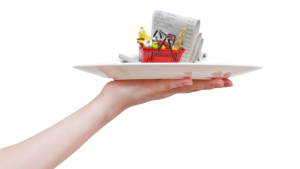“The COVID-19 pandemic has taken the world by surprise,” writes Zhecho Dobrev (@Zhecho_BeyondP), a Consultant at Beyond Philosophy. “The cost of life is dire. The economy is in shambles, many people around the world are in quarantine or being asked to keep a social distance. As always, the world will emerge from this. There could hardly be many winners out of this but some will emerge stronger or less shattered than others. As organizations emerge from this crisis, many are likely to face changing customer behavior and attitudes. Some of these will be driven by 1) the organizations’ response to the crisis and others will be driven by 2) changing customer habits and attitudes.”[1] In parts one and two of this article, I have discussed how areas in the food sector are being and could yet be impacted by the pandemic. I’ve drawn on insights provided by Jim Dippold, Senior Vice President for Category Management Strategy at Enterra Solutions®. Jim drew on numerous sources to produce the following insights. In part one of the article, I discussed Shopping Behavior Habits; Consumer Eating Habits; Retail In-store Operations; Retail Headquarter Operations; and Retailer Price and Promotion. In part two of the article, discussed: Retail Product Mix; Media; Supply; and Corporate Image. In this article, I’ll look at Jim’s final four areas: Business Forecast; Technology; Recession; and Society and Community. These areas look deeper into the future.
Business Forecast
Facts: Historically, companies that play the long game benefit from their foresight. One of the best ways to play the long game is to develop what-if scenarios based on assumptions related to the timing of the impact and when the world might get back to business-as-usual, or at least more-like-usual. Using this information, executives have the opportunity to quickly adjust plans to create ‘best scenario’ plans during this period of uncertainty, and then work together to ‘war game’ in order to accelerate plans to make up deficits as things trend in a more positive direction.
Inferences: Organizations should focus on what can happen in the remainder of 2020. Think long-term, act now, and set yourself up for post-crisis recovery. Leverage select teams and tools to dynamically model demand, pricing, planning and allocation. Develop back-to-business scenarios to accelerate business performance as the pandemic wanes. Retailers have to be thinking NOW about how they’re going to retain customer loyalty. Companies who plan now for post-pandemic/recession operations will be steps ahead of those that don’t — and that could make all the difference. Companies must avoid the temptation to simply drive short-term revenue and ignore long-term planning.
Technology
Facts: Social distancing will drive more consumers to digital platforms for their purchases. As a result, people will adopt new behaviors during this pandemic and they will likely keep using them long after the pandemic ends. The merging of convenience with personal safety has driven people who never considered buying groceries online to try it and like it. As a result, consumers have greater motivations and fewer perceived barriers to seek technology-enabled solutions to conduct daily activities, including shopping. For some consumers, the pandemic may create totally new behaviors (e.g., shopping for online for groceries), while for other consumers it simply means a ramping up of previous shopping behavior. The pandemic may also introduce some consumers to new technology, tools and software. The bottom line is this: COVID-19 will sweep away many of the artificial barriers to moving more of our lives online.
Inferences: Challenges arising from the spread of the novel coronavirus will likely accelerate consumer use of existing and new technologies and tools as they find them isolated and forced to work from home. Digital connectivity will support both personal and private connectivity. Isolation could also inspire new non-contact capabilities. Increased e-commerce is like to be sustained, even after immediate threats have subsided. Some pundits predict regulatory barriers to online tools will fall.
Recession
Facts: A recessionary period following the end of pandemic is certain. Millennials will face the second financial crisis in their young adult lives. Even before that, however, recession-Like behaviors will be seen thanks to mass furloughs and reduced incomes. Those behaviors will include brand switching from mainstream to value brands. Premium and top brands will become more insulated as consumers seek affordable luxuries. Retails will increase their private label offerings across price tiers as consumers search for better deals. Surveys show cost is valued more than convenience in difficult times. Consumers are likely to shift to value channels (e.g., Mass and Club). Convenience store and gas station channels will see an uptick in sales, correlating with gas prices and disposable income. Many restaurants will not survive the pandemic/ recession as consumers increasingly eat at home. Consumers will be forced to spend money on essentials such as rent, utilities, and food with little discretionary spending available. Faced with uncertain economic outlook, the most vulnerable parts of society are at increased risk. Some forecasts predict nearly 20% of all Americans will remain unemployed after the pandemic. As consumers pinch pennies on food, retail Dietitians can play an important role. The value of shelf-stable products demonstrated during the pandemic continues into the recession.
Inferences: Be aware of the emotional toll prolonged home confinement will have on consumers. Marketing messages must be adjusted to fit circumstances. To serve financially at-risk members of society, retailers and manufacturers will have to shift to smaller, lower-priced products. Strategies used in third world marketplaces will prove useful in first world settings.
Society and Community
Facts: The pandemic has enlightened millions about the fragility of life and the importance of community. As a result, there will be a renewed focus on family, both immediate and extended, as well as social cohorts. Consumers now know that touching things, being with other people, and breathing the air in an enclosed space can be risky. They also know unforeseen circumstances can cost them their jobs. 80 percent of Americans lack a significant financial cushion. Many people will struggle the emotional and financial impacts of job losses and family burdens. The income gap will likely become a growing political issue. The wealthiest fifth of Americans have made greater income gains than those below them in the income hierarchy in recent decades. Personal behavior will change. It’s been reported that people are staying up later and arising later. Business travel will continue to be very limited. Leisure travel almost be non-existent.
Inferences: Not every outcome from the pandemic will be bad. There will be a new appreciation for the greater good. Companies that went above and beyond for community, their customers, and, most importantly, their employees during this extraordinary time, will be rewarded with enduring loyalty. Those that didn’t, won’t. The end of mass quarantine will unleash pent-up demand for intimacy and a mini baby-boom could result. Despite the political ramifications, the inequality gap will widen. People will now perceive personal interaction as risky if not dangerous. We’ll be asking, is there any good reason to do this in person?
Some of the biggest societal changes could be political. Some experts are predicting a political uprising. Some pundits have predicted a new kind of patriotism will arise; one less characterized by polarization. Frankly, that depends on how November elections proceed. Some commentators see less individualism, new efforts at reform, and a return to faith. One of the important outcomes could be a renewed understanding that expertise matters. It was easy to sneer at experts until a pandemic arrived, and then people wanted to hear from medical professionals like Anthony Fauci. Stories will likely be written about the extent to which rich, well-connected and well-resourced communities will have been taken care of, while contingent, poor and stigmatized communities will have been thoroughly destroyed. Some political pundits believe big government will make a comeback and government service will regain its cachet. Trust in institutions will be restored, if and only if, government institutions — including those entrusted with protecting our health, preserving our liberties and overseeing our national security — are staffed with experts (not political loyalists). No one really knows how the future will unfold. Regardless of how it unfolds one thing is certain, the way people act and the priorities they set will determine that future.
Footnotes
[1] Zhecho Dobrev, “How Will Covid-19 Change Customer Behavior and Habits?” Beyond Philosophy Blog, 31 March 2020.





